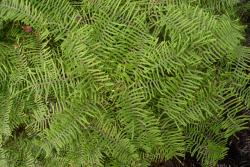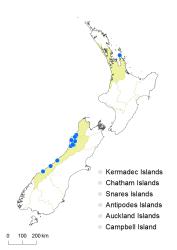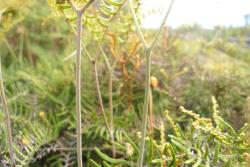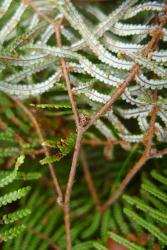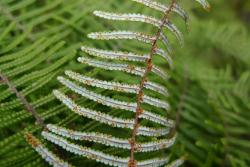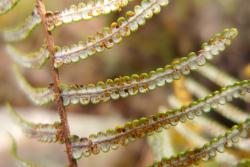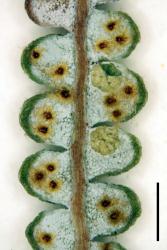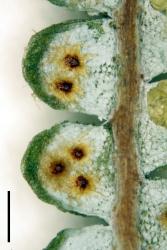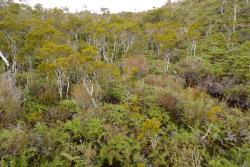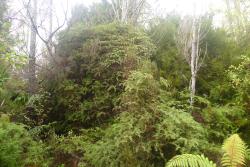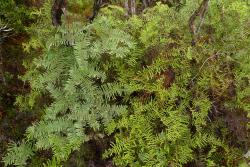Rhizomes long-creeping, 1–3 mm diameter; rhizome scales ovate or orbicular, 0.5–1.2 mm long, 0.5–0.8 mm wide, brown, peltate, bullate, ± entire. Fronds 130–1230+ mm long. Stipes 40–860 mm long, ± glabrous. Laminae 90–600+ mm long, 100–400+ mm wide. Rachis bud not extending or extending 1–2 times; rachis bud scales ovate, 1.5–2.5 mm long, 1–1.5 mm, dark brown with paler margins, ciliate or erose. Rachis bud without accessory leaflets. Pinnae 50–950+ mm long, 50–300 mm wide; with 1–4 (rarely 0) successive pseudodichotomous forks (excluding growth from pinna buds); pinna buds sometimes extending 1–2 times. Proximal-most costae 10–150 mm long, quickly glabrescent. γ costae (where not proximal-most costa) 10–40 mm long, with 0–4 pairs of costal leaflets. β costae 25–135 mm long, with 5–26 pairs of ultimate leaflets; adaxially with orange-brown or white branched scales with curly branches that form a lanate mass; abaxially with a mix of scales like those of the pinna buds and ultimate segments, glabrescent. Longest ultimate leaflets 13–59 mm long, with 15–47 pairs of ultimate segments. α costae adaxially ± glabrous; abaxially with scattered scales like those of the ultimate segments or glabrous. Ultimate segments 0.7–1.4 mm long, 0.9–1.4 mm, ovate, complanate or recurved, apices rounded; adaxially green, glabrous, complanate; abaxially white or glaucous, with orbicular to ovate scales, 0.3–0.8 mm long, 0.3–0.6 mm wide, dark brown with paler margins, long-ciliate, peltate, bullate. Sori c. ¾ embedded in lamina pit, each with 3 (rarely 4) sporangia. Spores 38.1–41.1 µm long, 42.7–45.5 µm wide (3 populations).
Gleichenia inclusisora is recognised by the sori being embedded within lamina pits, and by the comparatively large, bicolorous, ± orbicular scales on the abaxial surface of the laminae.
North Island: Auckland.
South Island: Western Nelson, Westland.
Altitudinal range: 5–840 m.
Gleichenia inclusisora has a stronghold in the Westport-Greymouth area, with populations scattered along the west coast of the South Island to about Haast. In the South Island, it occurs from near sea level to about 660 m above sea level. In the North Island, there is a single population in the northern Coromandel Peninsula, at about 840 m above sea level. An old collection (1920s or earlier) that is labelled as Ōpepe (herb. Eric Craig?, AK 115752 ), presumably near Taupō, is not mapped because this species has not been reported from the region subsequently; the locality is regarded as doubtful.
Gleichenia inclusisora occurs in pakihi (wet, infertile heaths) and open shrubland/treeland. It regularly occurs with other Gleichenia species, particularly G. dicarpa. Gleichenia inclusisora tends to be in rockier sites than G. dicarpa.
A single collection (Denniston, F. Overmars A17, WELT P026702, P026703) indicates that Gleichenia inclusisora hybridises rarely with G. alpina. Although there are few sori, they are embedded, and there are obvious scales on the abaxial surface of the ultimate segments, reflecting the involvement of G. inclusisora. However, these scales are larger, more ovate, and less-distinctly bicolorous than G. inclusisora, and the ultimate segments are abaxially more pouched, indicating the involvement of G. alpina or G. dicarpa. The large size of the scales suggests the other parent is more likely G. alpina than G. dicarpa; this is borne out by the hybrid’s chloroplast DNA sequence, which matches G. alpina (L.D. Shepherd unpub.).



